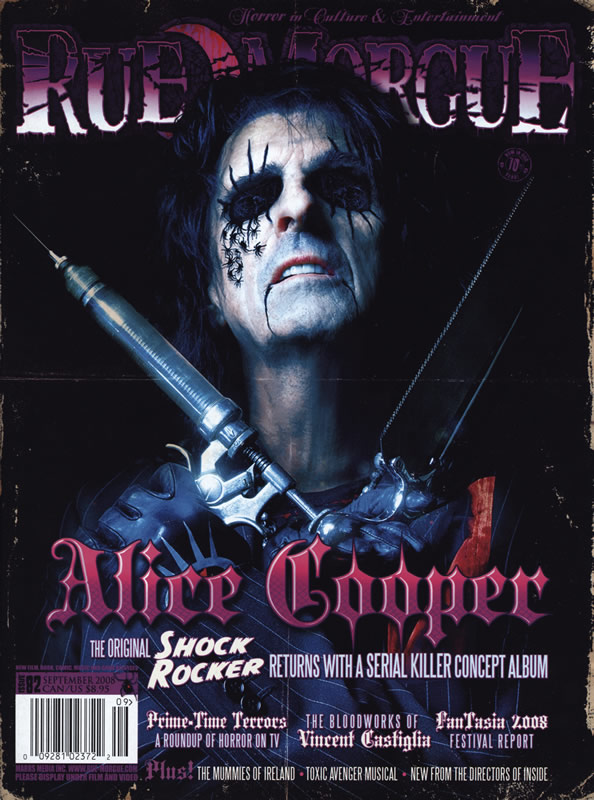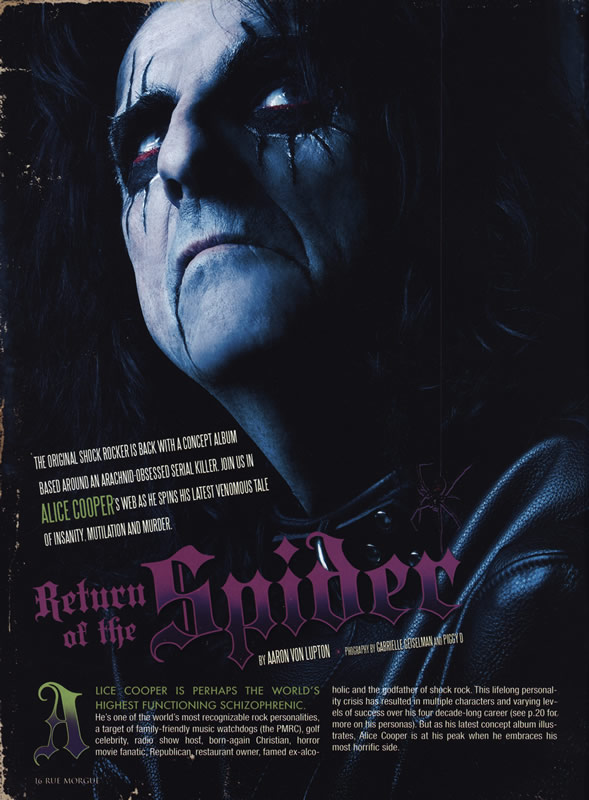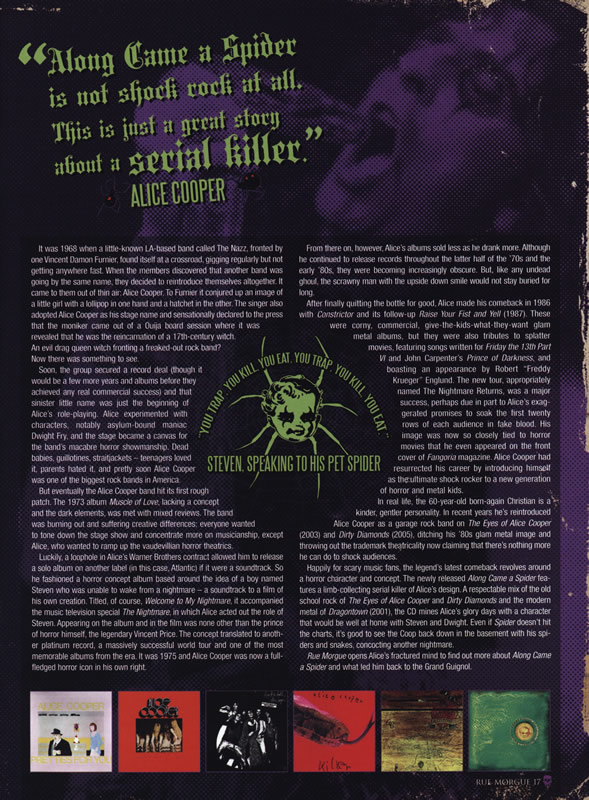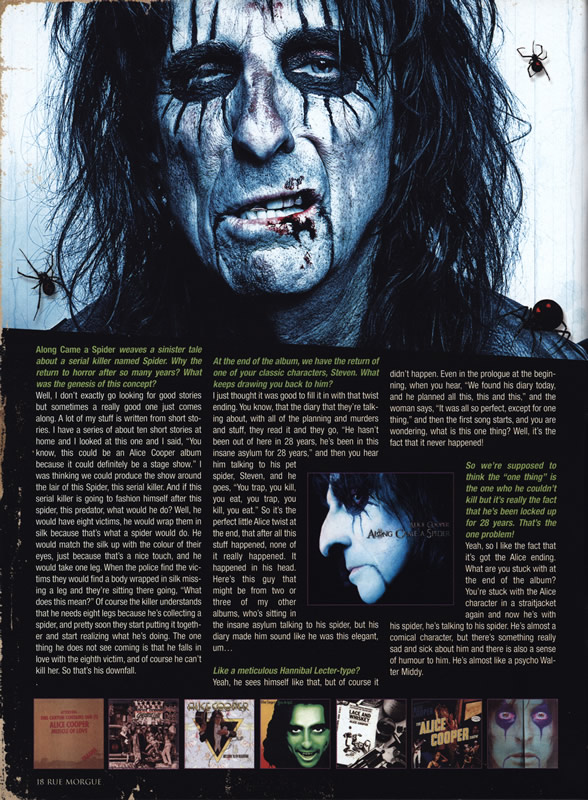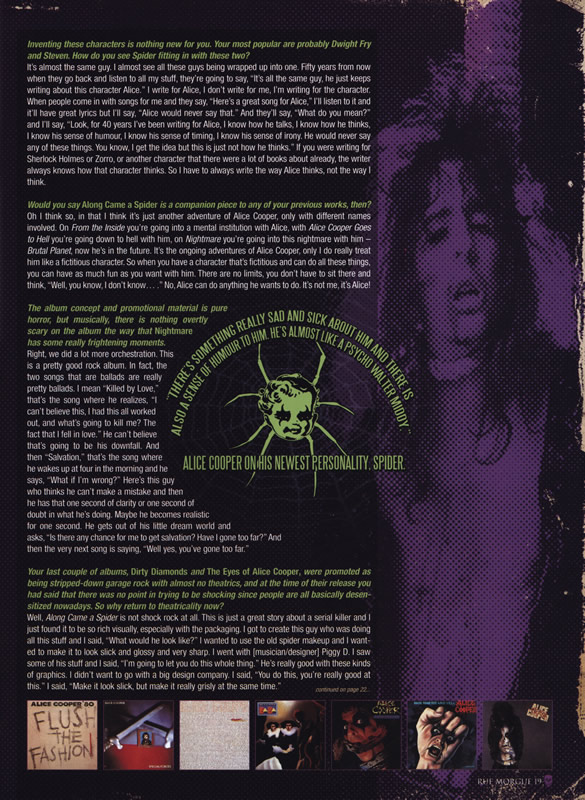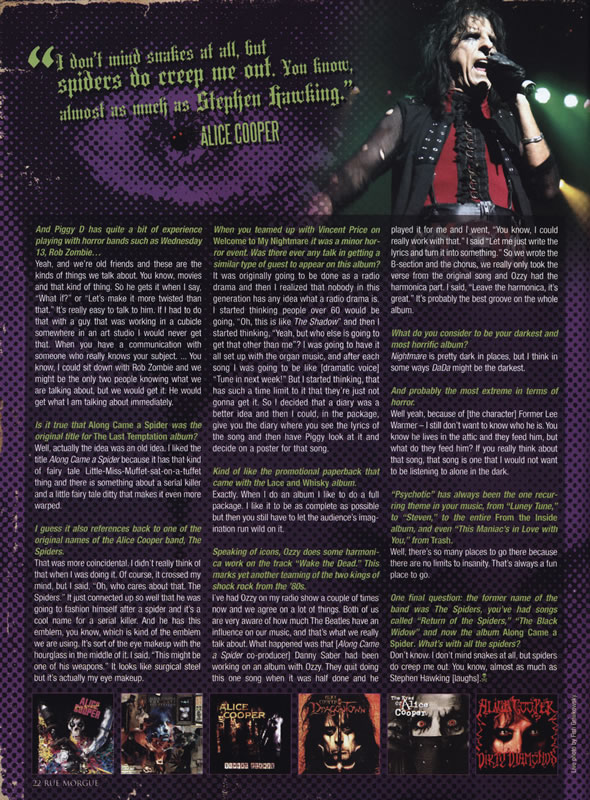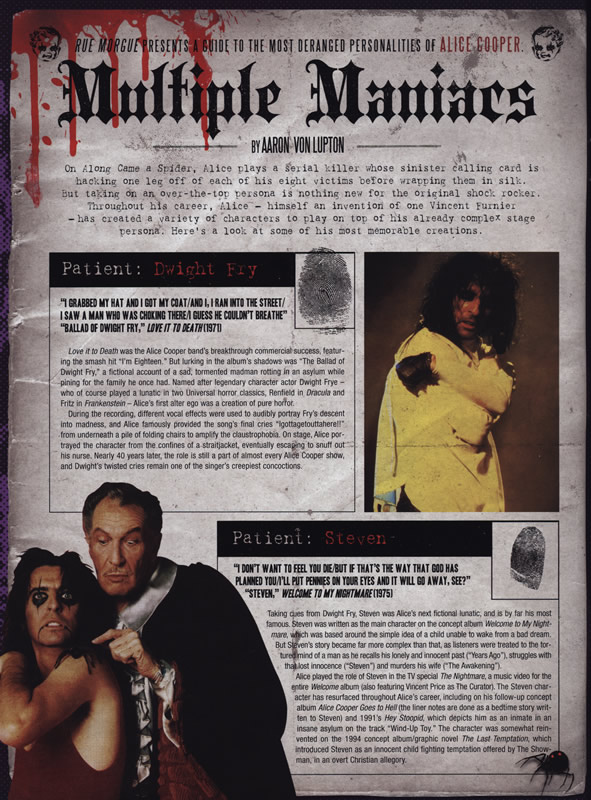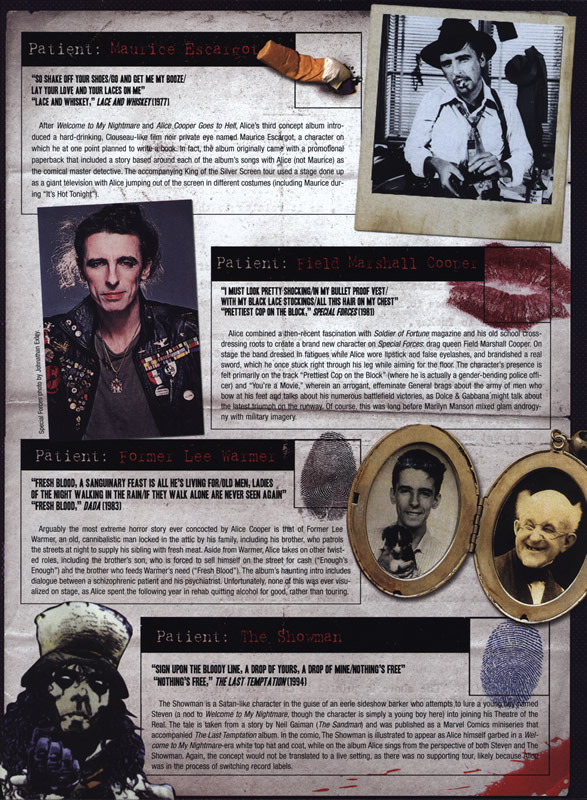Article Database
Return of the Spider
The original shock rocker is back with a concept album based around an arachnid-obsessed serial killer. Join us in Alice Cooper's web as he spins his latest venomous tale of insanity, mutilation and murder.
Alice Cooper is perhaps the world's highest functioning schizophrenic.
He's one the the world's most recognizable rock personalities, a target of family-friendly music watchdogs (the PMRC), golf celebrity, radio show host, born-again Christian, horror movie fanatic, Republican, restaurant owner, famed ex-alcoholic and the godfather of shock rock. This lifelong personality crisis has resulted in multiple characters and varying levels of success over his four decade-long career. But as his latest concept album illustrates, Alice Cooper is at his peak when he embraces his most horrific side.
It was 1968 when a little-known LA-based band called The Nazz, fronted by one Vincent Damon Furnier, found itself at a crossroad, gigging regularly but not getting anywhere fast. When the members discovered that another band was going by the same name, they decided to reintroduce themselves altogether. It came to them out of thin air: Alice Cooper. To Furnier it conjured up an image of a little girl with a lollipop in one hand and a hatchet in the other. The singer also adopted Alice Cooper as his stage name and sensationally declared to the press that the moniker came out of a Ouija board session where it was revealed that he was the reincarnation of a 17th-century witch. An evil drag queen witch fronting a freaked-out rock band? Now there was something to see.
Soon, the group secured a record deal (though it would be a few more years and albums before they achieved and real commercial success) and that sinister little name was just the beginning of Alice's role-playing. Alice experimented with characters, notably asylum-bound maniac Dwight Fry, and the stage became a canvas for the band's macabre horror showmanship. Dead babies, guillotines, straitjackets — teenagers loved it, parents hated it, and pretty soon Alice Cooper was one of the biggest rock bands in America.
But eventually the Alice Cooper band hit its first tough patch. The 1973 album Muscle of Love, lacking a concept and the dark elements, was met with mixed reviews. The band was burning out and suffering creative differences; everyone wanted to tone down the stage show and concentrate more on musicianship, except Alice, who wanted to ramp up the vaudevillian horror theatrics.
Luckily, a loophole in Alice's Warner Brothers contract allowed him to release a solo album on another label (in this case, Atlantic) if it were a soundtrack. So he fashioned a horror concept album based around the idea of a boy named Steven who was unable to wake from a nightmare — a soundtrack to a film of his own creation. Titled, of course, Welcome to My Nightmare, it accompanied the music television special The Nightmare, in which Alice acted out the role of Steven. Appearing on the album and in the film was none other than the prince of horror himself, the legendary Vincent Price. The concept translated to another platinum record, a massively successful world tour and one of the most memorable albums from the era. It was 1975 and Alice Cooper was now a full-fledged icon in his own right.
From there on, however, Alice's albums sold less as he drank more. Although he continued to release records throughout the latter half of the '70s and the early '80s, they were becoming increasingly obscure. But, like any undead ghoul, the scrawny man with the upside down smile would not stay buried for long.
After finally quitting the bottle for good, Alice made his comeback in 1986 with Constrictor and its follow-up Raise Your Fist and Yell (1987). These were corny, commercial, give-the-kids-what-they-want glam metal albums, but they were also tributes to splatter movies, featuring songs written for Friday the 13th Part VI and John Carpenter's Prince of Darkness, and boasting an appearance by Robert "Freddy Krueger" Englund. The new tour, appropriately named The Nightmare Returns, was a major success, perhaps due in part to Alice's exaggerated promise to soak the first twenty rows of each audience in fake blood. His image was now so closely tied to horror movies that he even appeared on the front cover of Fangoria magazine. Alice Cooper had resurrected his career by introducing himself as the ultimate shock rocker to a new generation of horror and metal kids.
In real life, the 60-year-old born-again Christian is a kinder, gentler personality. In recent years he's reintroduced Alice Cooper as garage rock band on The Eyes of Alice Cooper (2003) and Dirty Diamonds (2005), ditching his '80s glam metal image and throwing out the trademark theatricality now claiming that there's nothing more he can do to shock audiences.
Happily for scary music fans, the legend's latest comeback revolves around a horror character and concept. The newly released Along Came a Spider features a limb-collecting serial killer of Alice's design. A respectable mix of the old school rock of The Eyes of Alice Cooper and Dirty Diamonds and the modern metal of Dragontown (2001), the CD mines Alice's glory days with a character that would be well at home with Steven and Dwight. Even if Spider doesn't hit the charts, it's good to see the Coop back down in the basement with his spiders and snakes, concocting another nightmare.
Rue Morgue opens Alice's fractured mind to find out more about Along Came a Spider and what led him back to the Grand Guignol.
Along Came A Spider weaves a sinister tale about a serial killer named Spider. Why the return to horror after so many years? What was the genesis of this concept?
Well, I don't exactly go looking for good stories but sometimes a really good one just comes along. A lot of my stuff is written from short stories. I have a series of about ten short stories at home and I looked at this one and I said, "You know, this could be an Alice Cooper album because it could definitely be a stage show." I was thinking we could produce the show around the lair of this Spider, this serial killer. And if this serial killer is going to fashion himself after this spider, this predator, what would he do? Well, he would have eight victims, he would wrap them in silk because that's what a spider would do. He would match the silk up with the colour of their eyes, just because that's a nice touch, and he would take one leg. When the police find the victims they would find a body wrapped in silk missing a let and they're sitting there going, "what does this mean?" Of course the killer understands that he needs eight legs because he's collecting a spider, and pretty soon they start putting it together and start realizing what he's doing. The one thing he does not see coming is that he falls in love with the eighth victim, and of course he can't kill her. So that's his downfall.
At the end of the album, we have the return of one of your classic characters, Steven. What keeps drawing you back to him?
I just thought it was good to fill it in with that twist ending. You know, that diary that they're talking about, with all of the planning and murders and stuff, they read it and they go, "He hasn't been out of here in 28 years, he's been in this insane asylum for 28 years," and then you hear him talking to his pet spider, Steven, and he goes, "You trap, you kill, you eat, you trap, you kill, you eat." So it's the perfect little Alice twist at the end, that after all this stuff happened, none of it really happened. It happened in his head. Here's this guy that might be from two or three of my albums, who's sitting in the insane asylum talking to his spider, but his diary made him sound like he was this elegant, um...
Like a meticulous Hannibal Lector-type?
Yeah, he sees himself like that, but of course it didn't happen. Even in the prologue at the beginning, when you hear, "we found his diary today, and he planned all this, this and this," and the woman says, "It was all so perfect, except for one thing," and then the first song starts, and you are wondering, what is this one thing? Well, it's the fact that it never happened!
So we're supposed to think the "one thing" is the one he couldn't kill but it's really the fact that he's been locked up for 28 years. That's the one problem!
Yeah, so I look at the fact that it's got the Alice ending. What are you stuck with at the end of the album? You're stuck with the Alice character in a straitjacket again and now he's with his spider, he's talking to his spider. He's almost a comical character, but there's something really sad and sick about him and there is also a sense of humour to him. He's almost like a psycho Walter Middy.
Inventing these characters is nothing new for you. You most popular are probably Dwight Fry and Steven. How do you see Spider fitting in with these two?
It's almost the same guy. I almost see all these guys being wrapped up into one. Fifty years from now when they go back and listen to all my stuff, they're going to say, "It's all the same guy, he just keeps writing about this character Alice." I write for Alice, I don't write for me, I'm writing for this character. When people come in with songs for me and they say, "Here's a great song for Alice," I'll listen to it and it'll have great lyrics but I'll say, "Alice would never say that." And they'll say, "What do you mean?" and I"ll say, "Look, for 40 years I've been writing for Alice, I know how he talks, I know how he thinks, I know his sense of humour, I know his sense of timing, I know his sense of irony. He would never say any of these things. You know, I get the idea but this is just not how he thinks." If you were writing for Sherlock Holmes or Zorro, or another character that there were a lot of books about already, the writer always knows how that character thinks. So I have to always write the way Alice thinks, not the way I think.
Would you say Along Came a Spider is a companion piece to any of your previous works, then?
Oh I think so, in that I think it's just another adventure of Alice Cooper, only with different names involved. On From the Inside you're going into a mental institution with Alice, with Alice Cooper Goes To Hell you're going down to hell with him, on Nightmare you're going into this nightmare with him — Brutal Planet, now he's in the future. It's the ongoing adventures of Alice Cooper, only I do really treat him like a fictitious character. So when you have a character that's fictitious and can do all these things, you can have as much fun as you want him. There are no limites, you don't have to sit there and think, "Well, you know, I don't know..." No Alice can do anything he wants to do. It's not me, it's Alice!
The album concept and promotional material is pure horror, but musically, there is nothing overtly scary on the album the way that Nightmare has some really frightening moments.
Right, we did a lot more orchestration. This is a pretty good rock album. In fact, the two songs that are ballads are really pretty ballads. I mean "Killed by Love," that's the song where he realizes, "I can't believe this, I had this all worked out, and what's going to kill me? The fact that I fell in love." He can't believe that's going to be his downfall. And then "Salvation," that's the song where he wakes up at four in the morning and he says, "What if I'm wrong?" Here's this guy who thinks he can't make a mistake and then he has that one second of clarity or one second of doubt in what he's doing. Maybe he becomes realistic for one second. He gets out of his little dream world and asks, "Is there any chance for me to get salvation? Have I gone too far?" And then the very next song is saying, "Well yes, you've gone too far."
Your last couple of albums, Dirty Diamonds and The Eyes of Alice Cooper , were promoted as being stripped-down garage rock with almost no theatrics, and at the time of their release you had said that there was no point in trying to be shocking since people are all basically desensitized nowadays. So why return to theatricality now?
Well, Along Came a Spider is not shock rock at all. This is just a great story about a serial killer and I just found it to be so rich visually, especially with the packaging. I got to create this guy who was doing all this stuff and I said, "What would he look like?" I wanted to use the spider makeup and I wanted to make it look slick and glossy and very sharp. I went with [musician/designer] Piggy D. I saw some of his stuff and I said, "I'm going to let you do this whole thing." He's really good with these kinds of graphics. I didn't want to go with a big design company. I said, "You do this, you're really good at this." I said, "Make it look slick, but make it really grisly at the same time."
And Piggy D has quite a lot of experience playing with horror bands such as Wednesday 13, Rob Zombie...
Yeah, and we're old friends and these are the kinds of things we talk about. You know, movies and that kind of thing. So he gets it when I say, "What if?" or "Let's make it more twisted than that." It's really easy to talk to him. If I had to do that with a guy that was working in a cubicle somewhere in an art studio I would never get that. When you have a communication with someone who really knows your subject. ... You know, I could sit down with Rob Zombie and we might be the only two people knowing what we are talking about, but we would get it. He would get what I am talking about immediately.
Is it true that Along Came a Spider was the original title for The Last Temptation album?
Well, actually the idea was an old idea. I liked the title Along Came a Spider because it has that kind of fairy tale Little-Miss-Muffet-sat-on-a-tuffet thing and there is something about a serial killer and a little fairy tale ditty that makes it even more warped.
I guess it also reference back to one of the original names of the Alice Cooper band, The Spiders.
That was more coincidental. I didn't really think of that when I was doing it. Of course, it crossed my mind, but I said, "Oh, who cares about that. The Spiders." It just connected up so well that he was going to fashion himself after a spider and it's a cool name for a serial killer. And he has this emblem, you know, which is kind of the emblem we are using. It's sort of the eye makeup with the hourglass in the middle of it. I said, "This might be one of his weapons." It looks like surgical steel but it's actually my eye makeup.
When you teamed up with Vincent Price on Welcome to My Nightmare it was a minor horror event. Was there ever any talk in getting a similar type of guest to appear on this album?
It was originally going to be done as a radio drama and then I realized that nobody in this generation has any idea what a radio drama is. I started thinking people over 60 would be going, "Oh, this is like The Shadow" and then I started thinking, "Yeah, but who else is going to get that other than me"? I was going to have it all set up with the organ music, and after each song I was going to be like [dramatic voice] "Tune in next week!" But I started thinking, that has such a time limit to it that they're just not gonna get it. So I decided that a diary was a better idea and then I could, in the package, give you the diary where you see the lyrics of the song and then have Piggy look at it and decide on a poster for that song.
Kind of like the promotional paperback that came with the Lace and Whiskey album.
Exactly. When I do an album I like to do a full package. I like it to be complete as possible but then you still have to let the audience's imagination run wild on it.
Speaking of icons, Ozzy does some harmonica work on the track "Wake the Dead." This marks yet another teaming of the two kings of shock rock from the '80s.
I've had Ozzy on my radio show a couple times now and we agree on a lot of things. Both of us are very aware of how much The Beatles have an influence on our music, and that's what we really talk about. What happened was that [Along Came a Spider co-producer] Danny Saber had been working on an album with Ozzy. They quit doing this one song when it was half done and he played it for me and I went, "You know, I could really work with that." I said "Let me just write the B-section and the chorus, we really only took the verse from the original song and Ozzy had the harmonica part. I said, "Leave the harmonica, it's great." It's probably the best groove on the whole album.
What do you consider to be your darkest and most horrific album?
Nightmare is pretty dark in places, but I think in some ways DaDa might be the darkest.
and probably the most extreme in terms of horror.
Well yeah, because of [the character] Former Lee Warmer — I still don't want to know who he is. You know he lives in the attic and they feel him, but what do they feed him? If you really think about that song, that song is one that I would not want to be listening to alone in the dark.
"Psychotic" has always been the one recurring theme in your music, from "Luney Tune," to "Steven." to the entire From the Inside album, and even "This Maniac's in Love with You," from Trash.
Well, there's so many places to go there because there are no limits to insanity. That's always a fun place to go.
One final question: the former name of the band was The Spiders, you've had songs called "Return of the Spiders," "The Black Widow" and now the abum Along Came a Spider. What with all the spiders?
Don't know. I don't mind snakes at all, but spiders do creep me out. You know, almost as much as Stephen Hawking [laughs].
Multiple Maniacs
Rue Morgue present a guide to the most deranged personalities by Alice Cooper
On Along Came a Spider, Alice plays a serial killer whose sinister calling card is hacking one leg off of each of his eight victims before wrapping them in silk. But taking on an over-the-top persona is nothing new for the original shock rocker. Throughout his career, Alice — himself an invention of one Vincent Furnier — has created a variety of characters to play on top of his already complex stage persona. Here's a look at some of his most memorable creations.
Patient: Dwight Fry
"I grabbed my hat and I got my coat / And I, I ran into the street / I saw a man who was choking there / I guess he couldn't breathe"
"Ballad of Dwight Fry," Love It To Death (1971)
Love it to Death was the Alice Cooper band's breakthrough commercial success, featuring the smash hit "I'm Eighteen." But lurking in the album's shadows was "The Ballad of Dwight Fry," a fictional account of a sad, tormented madman rotting in an asylum while pining for the family he once had. Named after the legendary character actor Dwight Frye — who of course played a lunatic in two Universal horror classics, Renfield in Dracula and Fritz in Frankenstein — Alice's first alter ego was a creation of pure horror.
During the recording, different vocal effects were used to audibly portray Fry's descent into madness, and Alice famously provided the song's final cries "Igottagetouttahere!!" from underneath a pile of folding chairs to amplify the claustrophobia. On stage, Alice portrayed the character from the confines of a straitjacket, eventually escaping to snuff out his nurse. Nearly 40 years later, the role is still a part of almost every Alice Cooper show, and Dwight's twisted cries remain one of the singer's creepiest concoctions.
Patient: Steven
"I don't want to feel you die / But if that's the way that God has planned you / I'll put pennies on your eyes and it will go away, see?"
"Steven," Welcome To My Nightmare (1975)
Taking cues from Dwight Fry, Steven was Alice's next fictional lunatic, and is by far his most famous. Steven was written as the main character on the concept album Welcome to My Nightmare, which was based around the simple idea of a child unable to wake from a bad dream. But Steven's story became far more complex than that, as listeners were treated to the tortured mind of a man as he recalls his lonely and innocent passt ("Years Ago"), struggles with that lost innocence ("Steven") and murders his wife ("The Awakening").
Alice played the role of Steven in the TV special The Nightmare, a music video for the entire Welcome album (also featured Vincent Price as The Curator). The Steven character has resurfaced throughout Alice's career, including on his his follow-up concept album Alice Cooper Goes to Hell (the liner notes are done as a bedtime story written to Steven) and 1991's Hey Stoopid, which depicts him as an inmate in an insane asylum on the track, "Wind-Up Toy." The character was somewhat reinvented on the 1994 concept album/graphic novel The Last Temptation, which introduced Steven as an innocent child fighting temptation offered by The Showman, in an overt Christian allegory.
Patent: Maurice Escargot
"So shake off your shoes / Go and get me my booze / Lay your love and your laces on me"
"Lace and Whiskey," Lace and Whiskey (1977)
After Welcome to My Nightmare and Alice Cooper Goes to Hell, Alice's third concept alum introduced a hard-drinking, Clouseau-like film noir private eye names Maurice Escargot, a character on which he at one point planned to write a book. In fact, the album originally came with a promotional paperback that included a story based around each of the album's songs with Alice (not Maurice) as the comical master detective. The accompanying King of the Silver Screen tour used a stage done up as a giant television with Alice jumping out of the screen in different costumes (including Maurice during "It's Hot Tonight").
Patient: Field Marshall Cooper
"I must look pretty shocking / In my bullet proof vest / With my black lace stockings / All this hair on my chest"
"Prettiest Cop on the Block," Special Forces (1981)
Alice combined a then-recent fascination with Soldier of Fortune magazine and his old school cross-dressing roots to create a brand new character on Special Forces: drag queen Field Marshall Cooper. On stage the band dressed in fatigues while Alice wore lipstick and false eyelashes, and brandished a real sword, which he once stuck right through his leg while aiming for the floor. The character's presence is felt primarily on the track "Pretties Copt on the Block" (where he is actually a gender-bending police officer) and "You're a Movie," wherein an arrogant, effeminate General brags about the army of men who bow at his feet and talks about his numerous battlefield victories, as Dolce & Gabbana might talk about the latest triumph on the runway. Of course, this was long before Marilyn Manson mixed glam androdyny with military imagery.
Patient: Former Lee Warmer
"Fresh blood, a sanguinary feast is all he's living for / Old men, ladies of the night walking in the rain / If they walk alone are never seen again"
"Fresh Blood," Dada (1983)
Arguably the most extreme horror story ever concocted by Alice Cooper is that of Former Lee Warmer, an old, cannibalistic man locked in the attic by his family, including his brother, who patrols the streets at night to supply his sibling with fresh meat. Aside from Warmer, Alice takes on other twisted roles, including the brother's son, who is forced to sell himself on the street for cash ("Enough's Enough") and the brother who feeds Warmer's need ("Fresh Blood"). The album's haunting intro includes dialogue between a schizophrenic patient and his psychiatrist. Unfortunately, none of this ever was visualized on stage, as Alice spent the following year in rehab quitting alcohol for good, rather than touring.
Patient: The Showman
"Sign upon the bloody line, a drop of yours, a drop of mine / Nothing's free"
"Nothing's Free," The Last Temptation (1994)
The Showman is a Satan-like character in the guise of an eerie sideshow barker who attempts to lure a young boy named Steven (a not to Welcome to My Nightmare, though the character is simply a young boy here) into joining the Theatre of the Real. The tale is taken from a story by Neil Gaiman (The Sandman) and was published as a Marvel Comics miniseries that accompanied The Last Temptation album. In the comic, The Showman is illustrated to appear as Alice himself garbed in a Welcome to My Nightmare-era white top hat and coat, while on the album Alice sings from the perspective of both Steven and The Showman. Again, the concept would not be translated to a live setting, as there was no supporting tour, likely because Alice was in the process of switching record labels.



